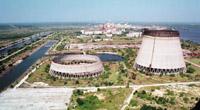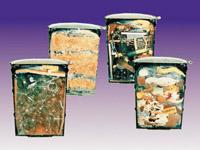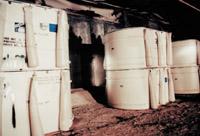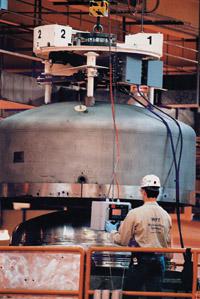Radioactive waste for our heirs
1999/11/01 Plazaola, Fernando Iturria: Elhuyar aldizkaria

At present, much of the electricity is obtained through nuclear energy. In some western states, France, Finland, Sweden, Switzerland... more than 50% of electricity comes from nuclear power stations. In addition, some of the aforementioned states have no military tradition.
Like most of the things, nuclear energy has its advantages and drawbacks, but this paper will not discuss the need to use or dispose of nuclear energy, we will talk about the radioactive waste that is generated in the nuclear fission reactions, especially in the current nuclear power plants. It is clear, without a doubt, that, from the point of view of nuclear power plants and nuclear power stations, the problem of nuclear waste is serious. Not only for the nuclear waste that can be generated, but because those generated so far have already become a problem. The problem of nuclear waste will be analyzed here.
The radioactive residue, or nuclear, is a matter constituted by unstable atoms that become stable atoms emitting ionizing radiation (alpha, beta or gamma radiation) without practical use. Nuclear waste is subdivided, but the state classification changes. The following figure is used in the United States:
- High-activity waste (HLW, High Level Waste). Among these residues are fission products from fission nuclear reactions. These are found in chemical elements between 1-65 and 81-96 and in some cases in isotopes of each chemical element. The products of these fission reactions are more than 200. Once the food is exhausted, it is reprocessed from several plants, such as the French one in The Hague, to obtain plutonium and enriched uranium, so that it can be reused in nuclear power plants and/or nuclear explosives. In reprocessing fission residues appear mixed with residues of high chemical toxicity, which are also residues of this type. Outside the commercial nuclear power plants, not forgetting France and the United Kingdom, especially in the United States and the former Soviet Union, for years the nuclear weapons industry has generated numerous waste of great activity.
- Transuranic waste (TRU, TRansUranic waste). This waste section is used only in the US. In the UK, for its part, a category of medium activity is defined to consider these residues, although this name is not very appropriate in some States that define different things by this name. The atomic number of residues in this category must be greater than 92 and in addition the activity per gram of residue must exceed 100 nests. These residues are usually alpha-emitters and can have a very long life, in some cases millions of years. Many of these residues are generated in the processing and reprocessing of plutonium for nuclear weapons and enriched uranium.
- Low activity waste (LLW, Low Level Waste). This type of waste is made up of radioisotope residues used in nuclear medicine, research laboratories, various industries (waste bins, iron and steel...). Also included are some products used in nuclear power plants (filters, contaminated equipment, clothing, etc. ). Most of the residues are of low activity and, in general, are constituted by radioactive isotopes of short life. In other words, residues that cannot be classified in the previous sections are residues of low activity. These residues are the most abundant and only in the US it is expected that by 2030 this type of waste reaches 5 million m3. These residues are located in superficial deposits, or near the surface, although in some places they are concentrated in old mines. In Spain, France and Japan there are moderately new surface deposits of this type, whose construction and protections are more sophisticated than those buried years ago in France, the United Kingdom, the Soviet Union and the United States. While in Czech Republic and Germany this type of waste is located in old mines, in Sweden and Finland special constructions have been made for the location of these waste.
Once the warehouses are filled, they are closed and kept under control until the radioactivity is destroyed, that is, between 200 and 300 years. Although the debate over these residues is not minimal, the problem is much less than that of other residues. In fact, what is done with these residues has a broad consensus in the scientific community. In addition, the risk of these residues is much lower than that of the other two.

The problem of other types of waste mentioned, especially high-activity waste, is more serious. The question is: What to do with high-activity radioactive waste? Currently, most of this type of waste is deposited in tanks located next to each nuclear power plant in tanks. These residues, when disintegrating and/or fisioning, release a lot of energy and in large part become heat. In this way, the location of the tanks produces a cooling of the tanks and, in addition, the water of the tanks acts as biological protection with respect to the radiation that crosses the tank, especially gamma radiation. These tanks are of special design and the residues that are located in them must be well classified and measured so that the accumulated residues are far from the critical mass. However, in some states, such as the US and Belgium, the tanks are also located in dry places, without entering tanks (the surface temperature of the tanks located on land can be around 160ºC). In general, these high-activity residues must be isolated for a very long time, until the number of unstable cores is negligible, that is, until most of the residues are stabilized. Otherwise, reaching human beings can cause great damage. This insulation period can be hundreds of thousands of years, due to the long half-life of many fission products that occur in fission reactions.
The term isolation is understood very well, but millennial isolation is made to a certain extent incomprehensible, since for it we must speak in temporal parameters as human existence. In addition, it is known that the treasures of the Egyptian pyramids, despite being so well kept, did not remain too long in this situation. In addition, who knows what will happen today's civilizations in much shorter timeframes... Is it not possible to shorten this long period of isolation? Is it not possible that these half-long life unstable nuclei that emit radioactivity become stable or short-lived nuclei?
The reaction or succession of reactions described in the previous questions is known as transmutation and, in recent decades, has been worked intensely in the search for high performance methods for the distribution and transmutation of long-life nuclei. The scientific bases are well known, for example 99Tc, a long-life fission product with a neuter that will be predated to become a 100Tc isotope and that, in fact, by beta-decay, becomes an element Ru of greater mass, by predation of two neutrons more to 102 stable Ru. However, in the transmutations of long-life nuclei in general several processes intervene and reaching a stable nucleus does not have to be an easy task.
The problems of transmutation are both technical and economic. From a technical point of view, nowadays it is possible to transmute with high performance the cores of long life. However, many of the radionucleids appear mixed in low concentrations and with other radioactive chemical and isotope elements. Very complex distribution processes are needed to distribute radioisotopes or individual groups and reduce their transmutation concentration to acceptable levels. This is very difficult for reprocessed materials. From an economic point of view, transmutations at a commercial level would require large distribution infrastructures and reactors. Reactors can be both critical and subcritical, guided by accelerators. Assuming that fission and transuranic products could be easily separated, only a small annual percentage could be effectively transmuted.

Therefore, the process of transmutation of long-life waste would take several decades and several generations of reactors would be needed. If the distribution were simple, things would be so, and it is known that one of the biggest obstacles in this whole process is in the distribution. The US Director of Radioactive Waste Management, Crowley says that "decades are still needed to know if the existing volumes of waste, and those that will occur in the future, can be subjected to practical transmutation at acceptable costs. Today this is impossible and technically advanced for waste management and the only economically combatable method is to isolate waste in deep, definitive geological layers."
Already in 1957 the scientists realized that in stable geological structures of bottom it was convenient to conserve long life residues isolated forever. And this is the procedure currently proposed as a solution. Opponents of this procedure affirm that this solution is cheap and has been taken into account to keep waste away from place and thought. The supporters, for their part, consider that this solution is a logical consequence of the decrease in the time of radioactivity, since over time the radioactive toxicity of waste is reduced.
Therefore, supporters of this solution have investigated deep geological structures with a stability of hundreds of thousands of years. However, there is still no such warehouse in operation and states with more advanced programs, Sweden and the US. They do not expect that in the next ten years, high-activity waste will begin to be located in this type of site. Most states do not foresee this solution until the middle of the next century.
This means that all high-activity waste is found in temporary locations. The provisional location is an important concept, since, before isolating the residues in geological structures of bottom, temporary warehouses are necessary for the residues to cool for decades, greatly reducing the activity of the short-lived nuclei. Some might say that the definitive warehouses are not prepared, since in most States there are still not sufficient residues of this type for their definitive location (except in the United States, where a quarter of all the nuclear power stations in the world are located). However, this is not the only reason that the residues remain in the provisional places, others are of great importance: a) the development and benevolence of technology for its definitive location has occurred more slowly than was thought — even in the scientific-technical community —, b) the selection and characterization of the site has become more complex than was expected (the US law requires that the risk after 10,000 years be highly calibrated and poorly responded to other projects. In recent years, work has been done at the international level to address the public's response, and after several meetings of experts, a report for the management of radioactive waste has been agreed, in order for states to sign it.
Although the in-depth location of waste has been proposed more than 40 years ago, and for example the "National Academy of Sciences" of the US. They consider that this is the best solution for radioactive waste, in the scientific-technical community there has always been an alternative contrary to this solution, arguing that it is not possible to find a definitive safe deposit or, at least, doubtful fund. However, those who oppose between scientists and technicians are minority, since the in-depth location of waste is the most accepted solution.
This solution consists of definitively closing the warehouse once full and avoiding the possibility of recovering its remains by burial. According to supporters of this solution, if there is a clear solution for high-activity waste, what needs to be done is to locate the right places and conduct studies and characterizations to isolate waste properly for thousands of years without potential risks.
In recent years, another of the ideas that has been extended is to keep the surface of the earth under control instead of burying the waste forever in depth. For many this proposal is very attractive because: a) the political and sociological problems that generate the location of the site are delayed, that is to say, they are left in the hands of future generations, b) the construction and maintenance of the warehouses corresponding to the producers of waste, of very high cost, are left for the future c) there are no problems of security in the short term, since there is technology to control this type of waste and is demonstrated undoubtedly. According to this proposal, the response to the problem is delayed until a "perfect solution", which is if it exists. In addition, researchers will have more time and money to investigate. It is clear that if we follow this path, the opposite of nuclear technology, undoubtedly, can affirm that the problem of high-activity waste remains unsolved. This debate, that of undermining or keeping them under surface control, was the one that was revealed when last year the management of radioactive waste in the French parliament was studied.

The rivals to keep waste under surface control, from an ethical point of view, affirm that the current generations are those who use the advantage of nuclear energy, so they must be responsible for the potential damages and not the coming generations. As I mentioned above, it is clear that if residues are maintained on the surface, the problem is not solved, it is delayed. But, contrary to this ethical argument, rather than leaving a buried and closed warehouse, it is better to leave options to future generations for them to decide, that is to say, there is still no need to make irreversible decisions, as in Sweden. Recently, Holland has ruled out the possibility of definitive warehouses in depth in its legislation. In the rest of States, there are also important pressures for the recovery of waste to be taken into account, that is, for in-depth storage to be recovered rather than closed when full. Among them are France, the United Kingdom, Sweden, Switzerland and Canada. In these States, it is being studied whether the recovery, control, and long-term maintenance are in line with the security objective that must be met without being disproportionate, since there is a concern that the isolation that produces the in-depth burial of the warehouse does not prevent its recovery.
However, despite the fact that planning for the definitive in-depth location of high-activity waste is one of the most developed in the US, this planning is also very advanced in some states in which the legal and political conditions are very demanding, as is the case of Sweden. In the 1970s, the Swedish nuclear program was limited to ensuring safe insulation of waste. Thus came the KBS-3 project, in which Sweden is currently the leader in waste management in different areas. During the year 2008 the first phase of the warehouse can be launched and a day's tank will be filled. The weight of each barrel will be 25 tons, with a quantity of high activity waste of 2 tons. Yes, these residues were going to cool for at least 25 years before their tonnage in another provisional place. In the case of the Swedes, it is not clear whether after filling this warehouse will be closed forever.
Probably two deep deposits that will close are being built in the US, one on Mount Yucca1 to isolate high-activity waste and another in the WIPP2 warehouse to isolate transuranic waste. The Yucca mountain warehouse is under construction in the state of Nevada, 160 km from Las Vegas. The WIPP warehouse is located in New Mexico, near the city of Carlsband.
Although it has not yet been fully executed, the length of the tunnels in the cell of Mount Yucca will be 250 km and 80,000 tons will be located in high activity waste tanks. Once closed, the maximum heat that the waste will produce will be 160 °C (at 50 years of its closure) and the environmental rock will be much drier than it is today. However, after hundreds of thousands or millions of years, the cuba will destroy corrosion and internal waste will escape. The goal of the Yucca mountain cell is to keep waste completely isolated for 10,000 years, as required by US law.
According to his calculations, from the health point of view, the risk that can exist once this period has passed would be similar to that which would have a natural location of uranium of the same size. The most dangerous of the more than 200 cores that will be located are those of long life, soluble in water and that are not usually absorbed in rocks and soil. Among the most dangerous of Mount Yucca are C-14, Chloro36, Cesio-135, Neptunio-237, Iodo-129, Kurio-245 and Teknezio-99. The isolation and safety of these isotopes is very important. Concerns about whether these isotopes will last long enough isolated come from different places: 1) What would happen if within 7,000 years people excavated the mountain? 2) In case of earthquakes or volcanic actions? 3) However, the one that causes the most panic is the hydrological one. Mount Yucca is a desert (15 cm of precipitation per year), and although most of the rain evaporates rapidly, water, although very little, can penetrate inside through the cracks of the soil. This could advance the intrinsic corrosion of the tanks for thousands of years, and the water would drag the radioactive isotopes dissolved in them about 300 m below and remove them along with the water from it. This is the most studied possibility in the two above mentioned warehouses. However, analyzing the possibilities, scientific analyses indicate that ten thousand years after the closure of the warehouse, the number of radioisotopes that could escape this water can be very small, less than the one that can be found in the different sources that we currently consume.

Gai honi buruzko eduki gehiago
Elhuyarrek garatutako teknologia




